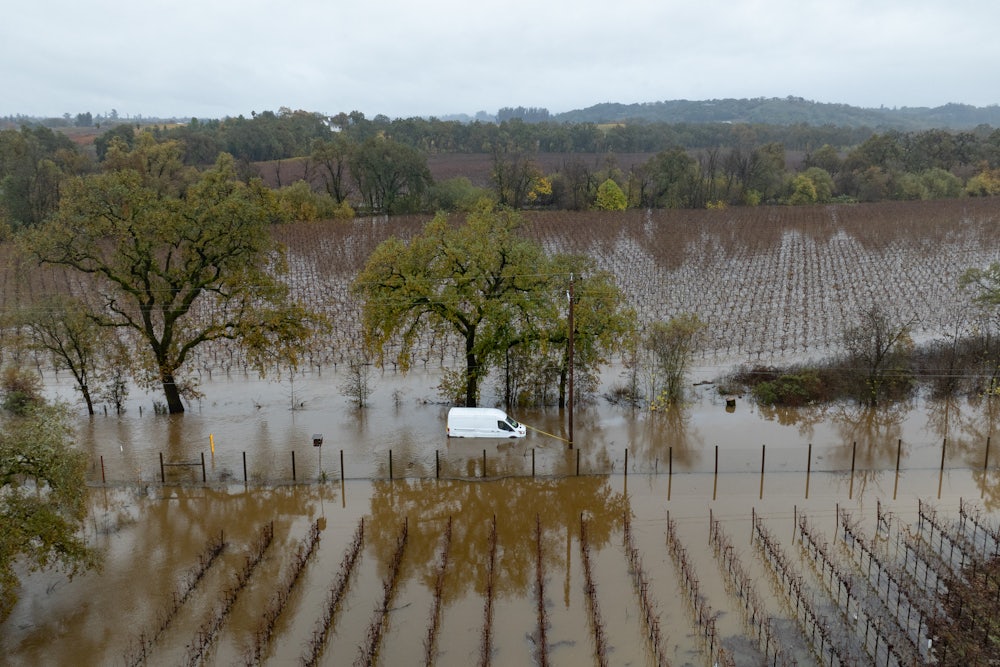Over the last two months, Arkanasas has been pummeled by “once-in-a-generation” flooding and dozens of tornadoes. The Trump administration has denied a request from Governor Sarah Huckabee Sanders—who served as Trump’s press secretary from 2017 to 2019—to make a major disaster declaration, which would unlock federal response and recovery resources that would help individuals and local governments deal with the damage and rebuild. With red and blue states facing similar denials—the administration has rebuffed requests from Washington state and from North Carolina’s Democratic governor—the White House’s message to disaster-ravaged states has been clear: You’re on your own.
The staff and budget reductions and sweeping changes that have defined the administration’s first 100 days will likely make future disasters even worse. As hurricane season looms, the White House is making dramatic cuts to federal disaster response and preparedness. Roughly 20 percent of full-time permanent staff at the Federal Emergency Management Agency—including civil servants responsible for disaster response and recovery operations—are expected to take voluntary buyouts offered by Elon Musk’s so-called Department of Government Efficiency. The administration is further looking to raise the threshold for states to qualify for public assistance, as part of a drive to shift the burden for those costs to state and local governments. It’s also already ended funding for a $5 billion program to fund local risk-mitigation efforts. On Tuesday, the White House announced appointees to the FEMA Review Council. Tasked with “reforming and streamlining” emergency management and disaster response, it will be chaired by Homeland Security Secretary Kristi Noem and Defense Secretary Pete Hegseth.
“The federal disaster safety net is at risk of unraveling right now,” says Rob Moore, director of flooding solutions and environmental health at the Natural Resources Defense Council. “If you’re a local government official, a governor, or somebody who’s lived through a disaster in the past, you should be worried about what this hurricane, wildfire, and flood season has in store for you. There’s a very good chance that the federal assistance you might have relied upon won’t be there this time around.”
Trump has repeatedly floated the idea of disbanding FEMA altogether. Noem has echoed that stance in recent weeks, going so far as to say, “We’re going to eliminate FEMA” as soon as this year.
Thousands of people still recovering from last year’s hurricane season are getting a preview of what America would look like without FEMA. In March, the agency stopped paying for temporary housing for more than 1,200 families displaced by Hurricane Helene in North Carolina. Some Floridians reported being told to find beds in homeless shelters when FEMA stopped paying for their temporary housing last month too.
In recent weeks, FEMA has denied North Carolina’s request for full reimbursement in ongoing efforts to clean up millions of cubic feet of debris from Hurricane Helene, which could now cost the state as much as $200 million. Residents of eight West Virginia counties won’t be eligible to apply for individual assistance grants from FEMA to rebuild from devastating flooding there in February; two counties in the state were denied public assistance funds used to rebuild municipal buildings, bridges, and other infrastructure.
The White House continues to insist that state and local governments should be responsible for the lion’s share of the burden for disaster preparedness and response, and blames them for not doing more. National Security Council spokesman Brian Hughes told the news outlet Stateline that states and local governments “often remain an impediment to their own community’s resilience,” urging states to ramp up emergency management staffing, strategic investments, “commonsense policies that prioritize preparedness over politics,” and “above all, an appetite to own the problem.”
Emergency management experts say states simply don’t have the capacity to to take on functions that have long been the remit of the federal government. “I cannot think of a single state that is prepared to have that responsibility pushed back onto them,” says Caroline Hackerott, assistant professor of disaster resilience and emergency management at North Dakota State University. While larger cities might have dedicated emergency management offices and staff, towns and rural areas often don’t. She relayed a story of one local emergency management official in North Dakota who also managed the 911 call center and noxious weed department. “Her assignment for emergency management was four hours a week,” Hackerott said.
She notes that state and local emergency management capacities rely heavily on federal programs such as the Emergency Management Preparedness Grant, or EMPG. Administered by states to local governments, that program covers 50 percent of the costs for local emergency management system coordinator positions, including salaries, vehicle usage, and office supplies. That program is currently on hold as a result of the administration’s federal funding freeze. Illinois Attorney General Kwame Raoul has stated that more than $200 million in federal disaster preparedness and recovery grants for the state’s Emergency Management Agency is on hold. FEMA has reportedly also canceled several trainings and courses meant to better equip local and state emergency managers for disaster response and preparedness and standardize protocols so they can plug in to relief efforts elsewhere.
The most valuable aspects of emergency management, experts caution, happen well before disaster strikes. Toward that end, FEMA provides modest funding to reduce the cost and harm caused by disasters that are becoming more frequent and severe as a result of climate change. The Government Accountability Office finds that the number of disasters FEMA manages has more than doubled in the last seven years, “from 30 disasters in 2016 to 71 disasters in 2023.” According to the National Institute of Building Sciences, every $1 invested in mitigation activities to reduce risk and disaster losses saves an average of $6.
Earlier this month, meanwhile, the Department of Homeland Security bragged about eliminating the “wasteful, politicized” Building Resilient Infrastructure and Communities, or BRIC, grant program, clawing back $3.6 billion earmarked for states and local governments to reduce hazard risk. Florida now stands to lose nearly $300 million for hurricane aid and flood mitigation efforts previously approved by FEMA officials, as just 6 percent of those funds have already been spent. Louisiana will lose $185.5 million for 34 projects that were exclusively funded by BRIC, including to build levees and elevate homes. Unspent funds will be returned to either the Disaster Relief Fund or the U.S. Treasury. Twenty-two states and the District of Columbia have filed a lawsuit demanding that already obligated federal funds, including from FEMA, be released.
With hurricane season just weeks away, the White House’s attacks on the country’s disaster response and preparedness systems could prove devastating. “They’re decimating these state agencies at the same time that they’re trying to reassign responsibility and accountability to them,” Hackerott told me. “It’s an unfunded mandate, and it’s going to affect all of us.”




